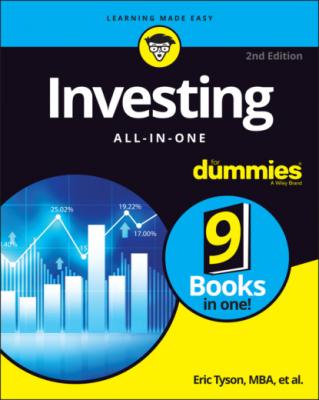Investing All-in-One For Dummies. Eric Tyson
Читать онлайн.| Название | Investing All-in-One For Dummies |
|---|---|
| Автор произведения | Eric Tyson |
| Жанр | Личные финансы |
| Серия | |
| Издательство | Личные финансы |
| Год выпуска | 0 |
| isbn | 9781119873051 |
When you invest in certain securities — such as stocks and bonds and exchange-traded funds (ETFs) — and when you want to hold mutual funds from different companies in a single account, you need brokerage services. Brokers execute your trades to buy or sell stocks, bonds, and other securities and enable you to centralize your holdings of mutual funds, ETFs, and other investments. Your broker can also assist you with other services that may interest you.
Deciding which investment company is best for you depends on your needs and wants. In addition to fees, consider how important having a local branch office is to you. If you want to invest in mutual funds, you’ll want to choose a firm that offers access to good funds, including money market funds in which you can deposit money awaiting investment or proceeds from a sale.
Finding an acceptable advisor
Be sure to get educated before engaging the services of any financial advisor. How can you possibly evaluate the competence of someone you may hire if you yourself are financially clueless? You’ve got this book, so read it before you consider hiring someone for financial advice.
By taking the themes and major concepts of this book to heart, you greatly minimize your chances of making significant investment blunders, including hiring an incompetent or unethical advisor. You may be tempted, for example, to retain the services of an advisor who claims that their firm can predict the future economic environment and position your portfolio to take advantage. But you find in reading this book that financial advisors don’t have crystal balls and that you should steer clear of folks who purport to be able to jump into and out of investments based upon their forecasts.
Because investment decisions are a critical part of financial planning, take note of the fact that the most common designations of educational training among professional money managers are MBA (master of business administration) and CFA (chartered financial analyst). Financial planners often have the CFP (certified financial planner) credential, and some tax advisors who work on an hourly basis have the PFS (personal financial specialist) credential.
Advisors who provide investment advice and oversee at least $100 million must register with the U.S. Securities and Exchange Commission (SEC); otherwise, they generally register with the state that they make their principal place of business. All advisors must file Form ADV, otherwise known as the Uniform Application for Investment Adviser Registration. This lengthy document asks investment advisors to provide in a uniform format such details as a breakdown of where their income comes from, their education and employment history, the types of securities the advisory firm recommends, and the advisor’s fee schedule.
www.adviserinfo.sec.gov. Many states require the registration of financial advisors, so you should also contact the department that oversees advisors in your state. Visit the North American Securities Administrators Association’s website (www.nasaa.org), and click the Contact Your Regulator link on the home page.
Chapter 2
Weighing Risks and Returns
IN THIS CHAPTER
A woman passes up eating a hamburger at a picnic because she heard that she could contract a deadly E. coli infection from eating improperly cooked meat. The next week, that same woman hops in the passenger seat of her friend’s old-model car that lacks airbags.
Risk is in the eye of the beholder. Many people base their perception of risk, in large part, on their experiences and what they’ve been exposed to. In doing so, they often fret about relatively small risks while overlooking much larger risks.
Sure, a risk of an E. coli infection from eating poorly cooked meat exists, so the woman who was leery of eating the hamburger at the picnic had a legitimate concern. However, that same woman got into her friend’s car without an airbag and placed herself at far greater risk of dying in that situation than if she had eaten the hamburger. In the United States, more than 35,000 people typically die in automobile accidents each year.
In the world of investing, most folks worry about certain risks — some of which may make sense and some of which may not — but at the same time, they completely overlook or disregard other, more significant risks. This chapter discusses a range of investments and their risks and expected returns.
Evaluating Risks
Everywhere you turn, risks exist; some are just more apparent than others. Many people misunderstand risks. With increased knowledge, you may be able to reduce or conquer some of your fears and make more sensible decisions about reducing risks. For example, some people who fear flying don’t understand that statistically, flying is much safer than driving a car. You’re approximately 110 times more likely to die in a motor vehicle than in an airplane. But when a plane goes down, it’s big news because dozens and sometimes hundreds of people, who weren’t engaging in reckless
